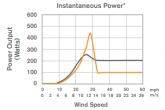svetz
Works in theory! Practice? That's something else
No deck?...my balcony is enclosed w sliding doors so the railings are outside the doors so there is no deck area...
Hmmm... that does complicate things and probably kills the generator idea.
...What about if I hang the solar panels from the railing so they face the sun directly and therefore no shadows from the railing poles?
I think you can get this to work, let's see how much power you can gather. Probably the next thing we need to know is how much weight you're comfortable lifting since you'll need to move/mount them. You need to not only be able to lift the panel, but also control it in case of a wind gust. Here's some examples:
20W panel: 6 lbs, 16.7" x 19.8" x 1.97", $10/W
From an earlier post you wrote:
... i have direct sunlight [from the] east [through] ... about 12 ... feet of ... glass doors. And then I have about 40” high railing with 6” opening between each rail.
The bad news is east facing, the good news is you have 12' of space. Each 100 watt panel is just over 2' wide, so you could have 5. Assuming you get between 20 and 50% of the insolation (given the east facing and stormy weather) that's roughly 500 to 1000 watts per day. That's just a rough guess... if you let us know at what time of day the southern edge of the railing starts to fall into shadow and the time of day the northern edge of the railing falls into shadow we can probably get you a closer number.
So, let's talk about mounting the solar panels and your situation.
First, the railing needs to be super-strong to support the weight of the panels and the forces from the wind blowing on them. Do you feel like the railing can support your weight both downwards and outwards? Five 100 Watt panels and mounting is probably going to exceed 100 lbs. With wind forces that gust to 50 mph (to be clear, don't put these out until well after the hurricane passes) could easily be a few hundred pounds laterally. If the railing is not super strong either make it so, or abandon this idea.
The nice thing about the 100W panels is that they're made for RVs so there is a wide variety of mounting options. You will need some sort of strong mounting, otherwise wind gusts will bash them into pieces in no time.
If the panels were south facing you can push the bottom of the panel away from the railing with the mount, you'll get a lot more power than having them at 90°. Even east facing you'll get more power with the bottom tilted away a bit. Commercial racks look a bit like this, instead of the pole you'd mount the top the railing. You could probably build something with angle iron if you're handy.

Finally, there will still be rain and the glass sliding doors will need to be open a crack to let the wiring through.
Last edited:









